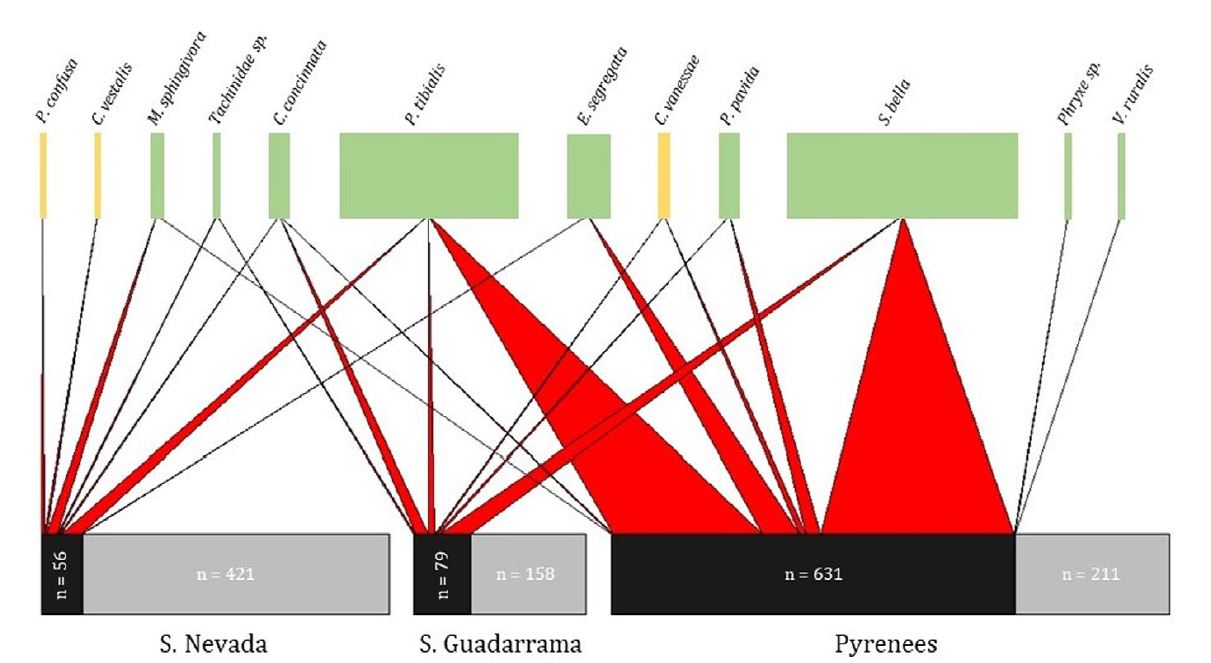Research lines
Butterflies ecology
The CBMS provides a huge amount of information on many aspects of the lives of butterflies and, in combination with more detailed studies, it represents a very useful tool for increasing knowledge of their ecology and behaviour. Since the beginning of the project, numerous collaborations have been established with researchers interested in different aspects, such as, what mutualistic and antagonistic relationships take place between butterflies, their food plants and their predators and parasitoids.
We are currently studying the mutualistic networks that are established between butterflies and the flowers they visit to feed on nectar. This will allow us to determine the species' preferences and identify which are their most important resources. Together with the data collected about the host plants on which the caterpillars feed(those that are aliment for the caterpillars), this information is very useful for a correct management to favour butterfly populationsthe favourable habitat management for these insects. On the other handAnother , one of our group’s the main lines of research in our group is the impact of parasitoids on the dynamic of butterfly populations dynamics. Parasitoids, which belong to a few families of Diptera (flies) and Hymenoptera (wasps), lay eggs on or in the immature stages of butterflies, which eventually die as a result., which they end up killing. In many butterfly populations, parasitoids represent a major mortality factor.

Parasitoids represent the main cause of mortality of eggs, caterpillars and pupae of most butterfly species. A paradigmatic example is that of the small tortoiseshell (Aglais urticae), whose caterpillars are attacked by a great diversity of tachinid flies and ichneumonid and braconid wasps. We have studied how this complex of natural enemies and their impact on the populations of this butterfly varies along a latitudinal gradient in the Iberian Peninsula.
- Esperk, T., Stefanescu, C., Teder, T., Wiklund, C., Kaasik, A. & Tammaru, T. (2013). Distinguishing between anticipatory and responsive plasticity in a seasonally polyphenic butterfly. Evolutionary Ecology, 27: 315-332.
- Kankare, M., Stefanescu, C., van Nouhuys, S. & Shaw, M.R. (2005). Host specialization by Cotesia wasps (Hymenoptera: Braconidae) parasitizing species-rich Melitaeini (Lepidoptera: Nymphalidae) communities in north-eastern Spain. Biological Journal of the Linnean Society, 86: 45-65.
- Nylin, S., Nygren, G.H., Söderlind, L. & Stefanescu, C. (2009). Geographical variation in host plant utilization in the comma butterfly: the roles of time constraints and plant phenology. Evolutionary Ecology, 23: 807-825.
- Olesen, J.M., Stefanescu, C. & Traveset, A. (2011). Strong, long-term dynamics in an ecological network. PLoS ONE, 6(11): e26455.
- Stefanescu, C. (2001). The nature of migration in the red admiral butterfly Vanessa atalanta: evidence from the population ecology in its southern range. Ecological Entomology, 26: 525-536.
- Stefanescu, C. (2004). Seasonal change in pupation behaviour and pupal mortality in a swallowtail butterfly. Animal Biodiversity and Conservation, 27.2: 25-36.
- Stefanescu, C., Colom, P., Barea-Azcón, J.M., Horsdfield, D., Komac, B., Miralles, A., Shaw, M.R., Ubach, A., Gutiérrez, D. (2022). Larval parasitism in a specialist herbivore is explained by phenological synchrony and host plant availability. Journal of Animal Ecology. DOI 10.1111/1365-2656.13689
- Stefanescu, C.& Traveset, A. (2009). Factors influencing the degree of generalization in flower use by Mediterranean butterflies. Oikos, 118: 1109-1117.
Recommended references:




